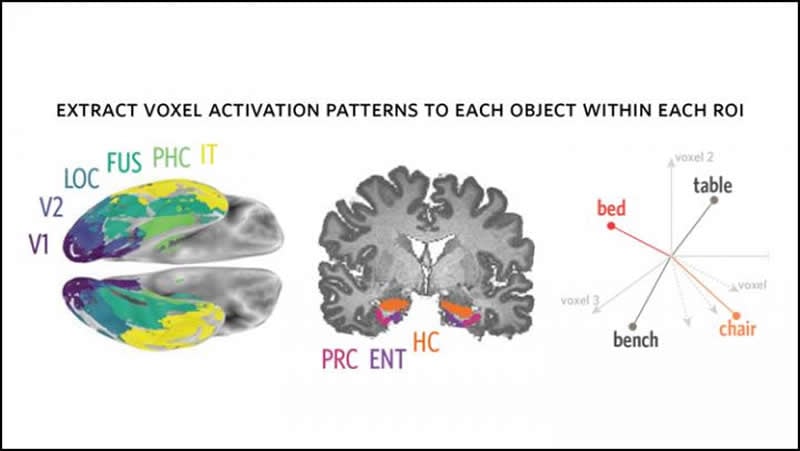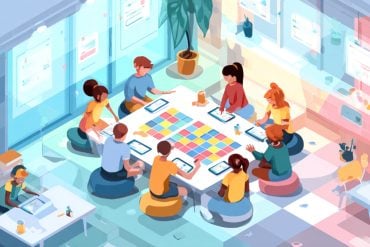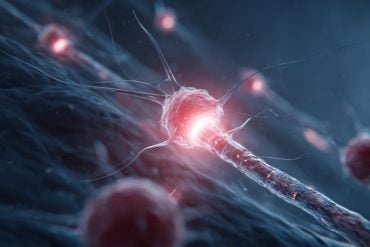Summary: Regions of the visual cortex participate in the recognition of an object and reproduction of the object when drawing. The study provides new insight into the relationship between visual production and recognition in the brain.
Source: SfN
Drawing an object and naming it engages the brain in similar ways, according to research recently published in Journal of Neuroscience. The finding demonstrates the importance of the visual processing system for producing drawings of an object.
In a study by Fan et al., healthy adults performed two tasks while the researchers recorded brain activity using functional magnetic resonance imaging: they identified pieces of furniture in pictures and produced drawings of those pieces of furniture. The researchers used machine learning to discover similar patterns of brain activity across both tasks within the occipital cortex, an area of the brain important for visual processing. This means people recruit the same neural representation of an object whether they are drawing it or seeing it.

As the participants drew each object multiple times, the activity patterns in occipital cortex remained unchanged, but the connection between occipital cortex and parietal cortex, an area involved in motor planning, grew more distinct. This suggests that drawing practice enhances how the brain shares information about an object between different regions over time.
Source:
SfN
Media Contacts:
Calli McMurray – SfN
Image Source:
The image is credited to Fan et al., JNeurosci 2019.
Original Research: Closed access
“Relating visual production and recognition of objects in human visual cortex”. Research Articles, Behavioral/Cognitive
Relating visual production and recognition of objects in human visual cortex
Judith E. Fan, Jeffrey D. Wammes, Jordan B. Gunn, Daniel L. K. Yamins, Kenneth A. Norman and Nicholas B. Turk-Browne.
Journal of Neuroscience doi:10.1523/JNEUROSCI.1843-19.2019.
Abstract
Relating visual production and recognition of objects in human visual cortex
Drawing is a powerful tool that can be used to convey rich perceptual information about objects in the world. What are the neural mechanisms that enable us to produce a recognizable drawing of an object, and how does this visual production experience influence how this object is represented in the brain? Here we evaluate the hypothesis that producing and recognizing an object recruit a shared neural representation, such that repeatedly drawing the object can enhance its perceptual discriminability in the brain. We scanned human participants (N=31; 11 male) using fMRI across three phases of a training study: during training, participants repeatedly drew two objects in an alternating sequence on an MR-compatible tablet; before and after training, they viewed these and two other control objects, allowing us to measure the neural representation of each object in visual cortex. We found that: (1) stimulus-evoked representations of objects in visual cortex are recruited during visually cued production of drawings of these objects, even throughout the period when the object cue is no longer present; (2) the object currently being drawn is prioritized in visual cortex during drawing production, while other repeatedly drawn objects are suppressed; and (3) patterns of connectivity between regions in occipital and parietal cortex supported enhanced decoding of the currently drawn object across the training phase, suggesting a potential neural substrate for learning how to transform perceptual representations into representational actions. Taken together, our study provides novel insight into the functional relationship between visual production and recognition in the brain.
Significance Statement
Humans can produce simple line drawings that capture rich information about their perceptual experiences. However, the mechanisms that support this behavior are not well understood. Here we investigate how regions in visual cortex participate in the recognition of an object and the production of a drawing of it. We find that these regions carry diagnostic information about an object in a similar format both during recognition and production, and that practice drawing an object enhances transmission of information about it to downstream regions. Taken together, our study provides novel insight into the functional relationship between visual production and recognition in the brain.






